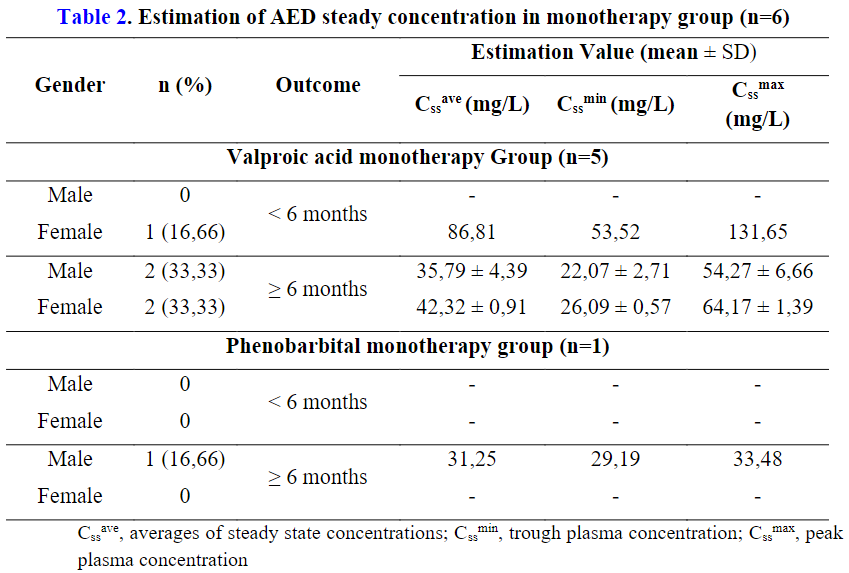Main Article Content
Abstract
Anti-epileptic drug (AED) has a narrow therapeutic index of drugs that a slight increase in dosage showed toxic effects. The therapeutic response is difficult to predict in malnutrition status because the patient with nutritional deficiency have more complicated problems likes hypoalbuminemia, macronutrient and micronutrients deficiency that affected the levels of AEDs. The nutritional deficiency could be a direct and indirect cause of ineffective AEDs therapy and also recurrent epilepsy. This study aims to describe the use of antiepileptic drugs in Indonesian children with poor nutritional status. The research design was observational studies with cross sectional random sampling to evaluate the AED doses of malnutrition status in children. All information was collected by spreading electronic forms and interviewing the parents by phone. The data were analyzed descriptively. Total of 8 malnourished children mostly included in the range of ages from >2 to 12 years (n=5; 62.50%) with means 3,9±2,7 years. The study showed valproic acid was bigger used in monotherapy (n=5; 62,50%) than polytherapy with carbamazepine or sodium phenytoin and phenobarbital. The means estimation of valproic acid monotherapy concentration in females’ group (n=2; 33,33%) showed sub-therapeutics level were Cssmin 26,09±0,57 mg/L and Cssmax 64,17±1,39 mg/L, also the means in males’ group (n=2; 33,33%) of valproic acid monotherapy were Cssmin 22.07±2,71 mg/L and Cssmax 54.27±6.66 mg/L. All of them included in good clinical outcome of free seizure > 6 months.
Keywords
Article Details

This work is licensed under a Creative Commons Attribution-NonCommercial 4.0 International License.
References
- Abbasi, A. A. (2020). Valproate Toxicity Medication. https://emedicine.medscape.com/article/819315-medication
- Andrianti, P. T., Gunawan, P. I., & Hoesin, F. (2016). Profil Epilepsi Anak dan Keberhasilan Pengobatannya di RSUD Dr. Soetomo Tahun 2013. Sari Pediatri, 18(1), 34. https://doi.org/10.14238/sp18.1.2016.34-39
- Aydin, K., Kartal, A., & Keles, E. A. (2019). High rates of malnutrition and epilepsy: two common comorbidities in children with cerebral palsy. Turkish Journal Of Medical Sciences, 49(1), 33–37. https://doi.org/10.3906/sag-1803-79
- Crepin, S., Godet, B., Chassain, B., Preux, P. M., & Desport, J. C. (2009). Malnutrition and epilepsy: A two-way relationship. Clinical Nutrition, 28(3), 219–225. https://doi.org/10.1016/j.clnu.2009.03.010
- Dipasquale, V., Cucinotta, U., & Romano, C. (2020). Acute Malnutrition in Children: Pathophysiology, Clinical Effects and Treatment. Nutrients, 12(8), 2413. https://doi.org/10.3390/nu12082413
- Fazeli-Bakhtiyari, R., Panahi-Azar, V., Sorouraddin, M. H., & Jouyban, A. (2015). Determination of valproic acid in human plasma using dispersive liquid-liquid microextraction followed by gas chromatography-flame ionization detection. Iranian Journal of Basic Medical Sciences, 18(10), 979–988. https://doi.org/10.22038/ijbms.2015.5461
- Freerks, L., Papadatou Soulou, E., Batchelor, H., & Klein, S. (2019). A review of GI conditions critical to oral drug absorption in malnourished children. European Journal of Pharmaceutics and Biopharmaceutics, 137(September 2018), 9–22. https://doi.org/10.1016/j.ejpb.2019.02.001
- Gampala, V. R., Peraboina, S. R., Ajmeera, S., Kalam, S., Adla, N., & Puchchakayala, G. (2017). Evaluation Of Sodium Valproate Levels In Malnourished Childhood Epilepsy and Its Consequences. Romanian Journal of Neurology, XVI(2), 53–61.
- Ghodke-Puranik, Y., Thorn, C. F., Lamba, J. K., Leeder, J. S., Song, W., Birnbaum, A. K., Altman, R. B., & Klein, T. E. (2013). Valproic acid pathway: pharmacokinetics and pharmacodynamics. https://doi.org/10.1097/FPC.0b013e32835ea0b2
- Lingga, H. N., Hakim, L., & Pramantara, I. D. P. (2013). Evaluasi Dosis Asam Valproat Pada Pasien Epilepsi Anak. Jurnal Manajemen Dan Pelayanan Farmasi.
- Marvanova, M. (2016). Pharmacokinetic characteristics of antiepileptic drugs (AEDs). Mental Health Clinician, 6(1), 8–20. https://doi.org/10.9740/mhc.2015.01.008
- Medisa, D., & Diesty Anita Nugraheni. (2017). Jurnal Kedokteran dan Kesehatan Indonesia ward mental disorders. 2(3), 146–153.
- Methaneethorn, J. (2018). A systematic review of population pharmacokinetics of valproic acid. British Journal of Clinical Pharmacology, 84(5), 816–834. https://doi.org/10.1111/bcp.13510
- Soltani, D., Ghaffar pour, M., Tafakhori, A., Sarraf, P., & Bitarafan, S. (2016). Nutritional Aspects of Treatment in Epileptic Patients. Iran J Child Neurol. Summer, 10(3), 1–12.
- Suwarba, I. G. N. M. (2011). Insidens dan Karakteristik Klinis Epilepsi pada Anak. Sari Pediatri, 13(2), 123. https://doi.org/10.14238/sp13.2.2011.123-8
- Wijayatri, R., Ikawati, Z., & Ghofir, A. (2013). Perbandingan Monoterapi dan Politerapi pada Epilepsi Jenis Idiophatic Generalised Tonic Clonic. Jurnal Manajemen Dan Pelayanan Farmasi, 3(2).
- Winter, M. (2013). Basic Clinical Pharmacokinetics (J. Manurung, J. I. Panggabean, & S. Rachmawati (eds.); 5th ed.). Penerbit Buku Kedokteran EGC.
